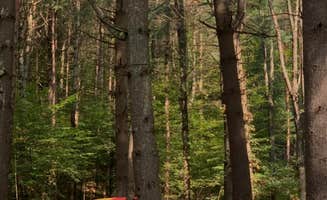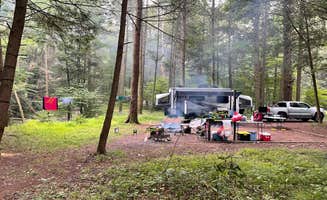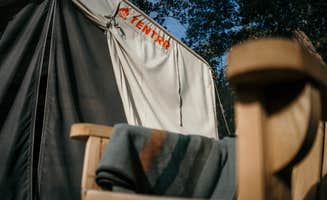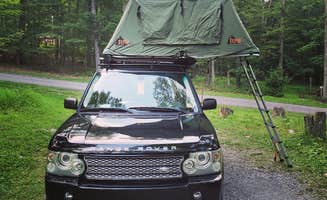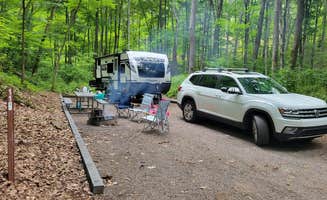Camping near Bittinger, Maryland offers a unique combination of highland forest ecology and four-season access. Located at elevations between 2,500-3,000 feet, the area maintains cooler temperatures than other parts of Maryland, with summer nights often dropping into the 50s. Winter camping opportunities expand with several campgrounds maintaining year-round sites, while spring brings dense wildflower displays in forest undergrowth.
What to do
Hiking the loop trails: New Germany State Park offers approximately 15 miles of marked trails with varying difficulty levels. "The trails are easy to medium and are open to cross country skiing in the winter months," notes Bill G. about New Germany State Park Campground.
Stream fishing: Multiple small waterways near Bittinger provide excellent trout fishing opportunities. At Big Run State Park Campground, the stream was "incredible and lively with trout and crayfish," according to Nathan S., making it ideal for anglers seeking quieter fishing spots.
Natural water features: Beyond swimming, the area's streams and falls offer cooling alternatives. "Muddy Creek Falls - the main attraction of the state park and the highest waterfall in Maryland - is the main reason to do the hike," notes Danielle V. about Swallow Falls State Park.
Winter recreation: Cross-country skiing becomes a primary activity when snow arrives. The trails at New Germany State Park transform into skiing routes, and as Sean M. notes, "It's a small park nestled in a little pristine valley that feels like you are in another world!"
What campers like
Unplugged experience: Cell service limitations create natural disconnection at many sites. "There is NO cell coverage in the park, so combined with the lack of hookups, this is definitely an unplugged, 'connect with nature' type of camping experience," explains Jen V. about New Germany State Park Campground.
Firefly displays: Summer evenings feature spectacular natural light shows. Simon S. noted while camping at Deep Creek Lake State Park that "We were lucky enough to witness a spectacular light show put up by thousands of fireflies at night."
Creek-side campsites: Stream-adjacent sites offer both ambiance and recreation. At Big Run State Park, Katie H. shared, "The best spots are in the woods adjacent to the stream. You can set up your camp chair and enjoy the creek sounds."
Wildlife viewing opportunities: Early mornings provide the best chance for deer sightings. Meredith P. at Savage River State Forest spotted "a raccoon, a bunny, a chipmunk, and (along the nearby roads) lots of deer— don't drive too fast!"
What you should know
Camping permit systems vary: Different forests and parks follow distinct reservation protocols. At Savage River State Forest, payment must be placed in specific locations as Grace D. notes: "The map indicated an iron ranger nearby these sites but we couldn't find it, so we ended up depositing our payment at the iron ranger at the white water sites."
Site selection importance: Campsite quality varies dramatically within the same campground. As Chris F. observed at Savage River, "The sites are very spread out, and not very consistent in size/quality. We were able to nab site 112 and it was fantastic: lots of space, and privacy too. However, we drove past some sites that looked sad and offering no seclusion."
Seasonal weather patterns: Temperature drops occur rapidly after sunset. The mountainous terrain maintains cooler temperatures year-round, making proper cold-weather gear necessary even in summer, especially since as Bill G. mentions about New Germany, "Summer temps usually do not get as nice 85max most of the summer."
Supply planning essential: Grocery and supply options are limited near most campgrounds. Chris F. notes that "to get potable water we had to drive ~20 minutes" at Savage River, while others recommend stocking up in larger towns like Frostburg before arrival.
Tips for camping with families
Beach access priorities: Lake beaches offer family-friendly swimming with facilities. At Rocky Gap State Park Campground, Katie H. appreciates that "the campground has their own beach so it's not over crowded with the public. Near the beach there is a nice playground near shade for parents to watch."
Trail difficulty assessment: Check trail maps for family-appropriate paths. Mike B. from Swallow Falls State Park Campground says, "The grounds had paths everywhere and were well kept. I didn't feel like I was walking in the dirt or through someone's campsite to get to the bathroom or the playground for the kids."
Campsite proximity to facilities: Select sites with young children based on bathroom access. At Rocky Gap, Katie H. notes their site was "incredibly spacious, heavily shaded, close to the bath house, path to the beach, and well distanced from other sites."
Wildlife education opportunities: Prepare children for animal sightings with proper guidelines. Christina C. at Deep Creek Lake State Park reported, "We did have a raccoon visitor, and a black bear while we were there. The paths are littered with very docile deer and the lake is crystal clear."
Tips from RVers
Pad size verification: Confirm actual campsite dimensions before booking. At Kentuck Campground — Ohiopyle State Park, Nora M. found "a wonderful, big electric and water site" but recommends verifying as site descriptions vary in accuracy.
Electrical limitations: Many campgrounds offer limited electrical sites with specific amperage. At Tub Run, Kathy G. recommends that RVers "stayed creekside to take advantage of the sewer connections" since many lakeside sites lack full hookups.
Water accessibility: Plan water fills carefully due to limited full-hookup sites. Gary P. at Swallow Falls State Park notes that while the campground had "84 campsites in the park and only 6 electric (&water)," making advance planning essential.
Winter camping readiness: For cold-weather camping, select sites with proper clearance. Bill G. notes New Germany State Park's Hemlock loop "is smaller and is mostly made for tent camping, though one site has electricity, but only big enough for a teardrop camper."



